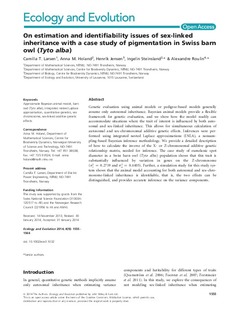| dc.contributor.author | Larsen, Camilla Thorrud | |
| dc.contributor.author | Holand, Anna Marie | |
| dc.contributor.author | Jensen, Henrik | |
| dc.contributor.author | Steinsland, Ingelin | |
| dc.contributor.author | Roulin, Alexandre | |
| dc.date.accessioned | 2017-10-30T13:17:46Z | |
| dc.date.available | 2017-10-30T13:17:46Z | |
| dc.date.created | 2014-04-25T20:30:06Z | |
| dc.date.issued | 2014 | |
| dc.identifier.citation | Ecology and Evolution. 2014, 4 (9), 1555-1566. | nb_NO |
| dc.identifier.issn | 2045-7758 | |
| dc.identifier.uri | http://hdl.handle.net/11250/2462906 | |
| dc.description.abstract | Genetic evaluation using animal models or pedigree-based models generally assume only autosomal inheritance. Bayesian animal models provide a flexible framework for genetic evaluation, and we show how the model readily can accommodate situations where the trait of interest is influenced by both autosomal and sex-linked inheritance. This allows for simultaneous calculation of autosomal and sex-chromosomal additive genetic effects. Inferences were performed using integrated nested Laplace approximations (INLA), a nonsampling-based Bayesian inference methodology. We provide a detailed description of how to calculate the inverse of the X- or Z-chromosomal additive genetic relationship matrix, needed for inference. The case study of eumelanic spot diameter in a Swiss barn owl (Tyto alba) population shows that this trait is substantially influenced by variation in genes on the Z-chromosome (math formula and math formula). Further, a simulation study for this study system shows that the animal model accounting for both autosomal and sex-chromosome-linked inheritance is identifiable, that is, the two effects can be distinguished, and provides accurate inference on the variance components. | nb_NO |
| dc.language.iso | eng | nb_NO |
| dc.publisher | Wiley Open Access | nb_NO |
| dc.rights | Navngivelse 4.0 Internasjonal | * |
| dc.rights.uri | http://creativecommons.org/licenses/by/4.0/deed.no | * |
| dc.title | On estimation and identifiability issues of sex-linked inheritance with a case study of pigmentation in Swiss barn owl (Tyto alba) | nb_NO |
| dc.type | Journal article | nb_NO |
| dc.type | Peer reviewed | nb_NO |
| dc.description.version | publishedVersion | nb_NO |
| dc.source.pagenumber | 1555-1566 | nb_NO |
| dc.source.volume | 4 | nb_NO |
| dc.source.journal | Ecology and Evolution | nb_NO |
| dc.source.issue | 9 | nb_NO |
| dc.identifier.doi | 10.1002/ece3.1032 | |
| dc.identifier.cristin | 1129987 | |
| dc.relation.project | Norges forskningsråd: 221956 | nb_NO |
| dc.relation.project | Norges forskningsråd: 223257 | nb_NO |
| dc.description.localcode | © 2014 The Authors. Ecology and Evolution published by John Wiley & Sons Ltd. This is an open access article under the terms of the Creative Commons Attribution License which permits use, distribution and reproduction in any medium, provided the original work is properly cited. | nb_NO |
| cristin.unitcode | 194,63,15,0 | |
| cristin.unitcode | 194,63,20,0 | |
| cristin.unitcode | 194,66,10,0 | |
| cristin.unitname | Institutt for matematiske fag | |
| cristin.unitname | Institutt for elkraftteknikk | |
| cristin.unitname | Institutt for biologi | |
| cristin.ispublished | true | |
| cristin.fulltext | original | |
| cristin.qualitycode | 1 | |

